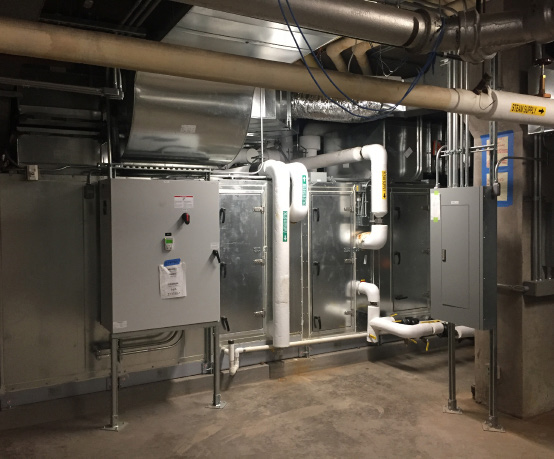Main Library Air Handler Replacement
IMEG provided mechanical and electric design services for the replacement of five air handing units (AHUs) in the basement of the historic downtown Davenport Public Library. The first phase of the project, completed in 2019, replaced three of the five air handling units, and the second phase of the project is currently under construction. The project was sequenced so only one AHU was disabled at any given time, allowing the library to continue operating during construction. The design also included a controls upgrade from a dated pneumatic system to a digital web-based system.
The narrow delivery path through single-width doors of the library, down stairs, and into to the mechanical room was a challenge for the design team, who used highly detailed field measurements and 3D modeling, to ensure parts could fit through doors to get into the space as well as fit in their final location. A mix of custom and modular style AHUs were specified to ensure all components would fit, and in some cases, coils were split into two separate sections, or single large fans split into multiple smaller fans. At the end of construction, each unit was required to pass a pressurized test to ensure the field erected units were sufficiently air-tight.
One of the original AHUs was designed with two zone dampers for increasing and decreasing airflow to two separate spaces. To address this zoning concept while still saving energy, the replacement unit for this space consisted of two completely separate airstreams built into one common air handling unit housing. Each airstream had its own fans, coils, and dampers, and were separated by an insulated partition. This gave each space completely independent control with lower energy costs than the original damper-based concept.
IMEG worked directly with the library facilities staff to address concerns regarding energy efficiency improvement, maintainability and reliability of the systems, and comfort for patrons and employees. To this end, the new energy-efficient AHUs use a mixture of electronically commutated (EC) motors and fans on variable frequency drives (VFDs) to vary the airflow rate. The heating and cooling coils are easier to clean and maintain due to new, larger access doors and new lights within the units, angled filter racks and larger housings reduce the frequency of filter changes, and larger coils allow the chiller systems to operate more efficiently and with greater capacity by operating at a higher temperature. The new digital controls allow the owner and maintenance staff to change space temperature setpoints, monitor equipment operation, and troubleshoot issues from any web browser, home or at work.









